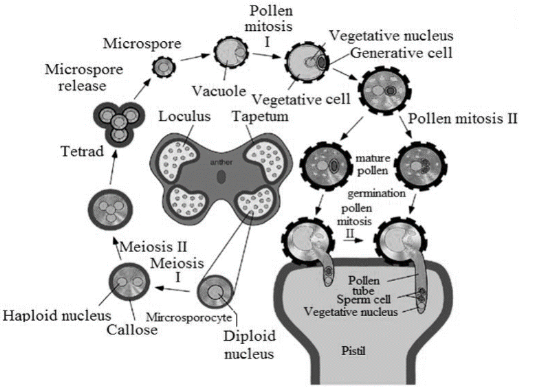Recommended: NEET Rank Predictor 2024
Latest: NEET 2024 Paper Analysis
Microsporangia are sporangia that produce microspores and create male gametophytes when germination occurs. The microsporangium is an important part of the gametophyte, the reproductive organ of plants, where pollen grains are formed. All vascular plants with heterosporic life cycles, such as seed plants, spike mosses, and the water fern genus Azolla, have microsporangia.
Microsporogenesis takes place inside the flowering plants’ microsporangia (anther). Spores are a plant’s reproductive organs. Microsporogenesis is the process by which microspores are generated inside pollen sacs, also known as Microsporangia.
Plants and plant parts can reproduce sexually in a variety of ways.
The gametophyte and sporophyte stages of the reproductive cycle are significantly diverse in different plant groups. Gametophytes produce male and female gametes, which unite to form a sporophyte. Let’s take a closer look at the topic and answer some important questions.
Microsporangia
Microsporangia are sporangia that produce male gametes and microspores. All plants with heterosporic life cycles, including spike mosses, have microsporangia. In gymnosperm and angiosperm anthers, microsporangia produce microsporocytes, the microspore mother cells, which then produce four microspores by meiosis.
Male plant gametophytes frequently develop and mature in the anther of the plant. The portions of the anther that produce pollen or microspores are known as microsporangia. To understand what a microspore is, we must first define it.
Microspores are plant spores that produce male gametophytes, which develop into sperm cells, which then fuse with egg cells to form a zygote.
Structure of Microsporangia
Microsporangia are bi-lobed structures found at the end of the long filament-like stamen that function as pollen sacs in a plant’s anther. Microsporangium has a circular form with four layers encircling it. The following are the details:
- When the epidermis matures, it stretches and then falls off in a specific pattern.
- A fibrous endothecium is a type of cell with fibrous ends
- The layers in the middle are the most important. The cells in the intermediary layers of a fully developed anther normally break down
- A tapetum layer with dense cytoplasm and uninucleate, binucleate, or multinucleate layers
Formation of Microsporangia
Microsporangium production is a complex biological process that begins in a plant’s early anther with actively growing meristematic cells. The pollen grains are found in the anther, which is a stamen component. These meristematic cells are surrounded by a thin layer of epidermis, which quickly expand into a bi-lobed structure.
Each lobe then generates a pair of pollen sacs, for a total of four pollen sacs on a two-lobed anther. These sacs are made up of cells that divide to form the primary sporogenous layer and are found in the four corners of the anthers. There’s a small difference between microsporangia and microsporangium as well. A sporogenous tissue container is a collection of microsporangium, whereas a microsporangium is a single container.
Microsporogenesis
Microsporogenesis is the meiotic or reduction division process that produces pollen grains (or microspores) inside the pollen sacs (or microsporangium) of flowering plants. Each microspore, which is the male gametophyte’s first cell that creates male gametes.
In other words, microsporogenesis happens when meiosis, or reduction division, occurs in the nucleus of each microspore mother cell, resulting in four haploid nuclei. Diploid sporogenous cells transform into microsporocytes (pollen mother cells or meiocytes) during the microsporogenesis process, which divide to produce four haploid microspores during meiosis.
Microsporogenesis is finished when individual single-celled haploid microspores arise from each diploid meiocyte’s tetrad of four haploid microspores.
Microsporogenesis Diagram

Process of Microsporogenesis
- Sporogenous tissue or microsporocytes fill the whole interior of a microsporangium, and their cells proliferate and multiply in tandem with the anther’s expansion.
- Each microsporocyte divides into a number of diploid microspore mother cells (MMC) or pollen mother cells (PMC) during mitosis
- The microspore mother cells form an interior layer of callose (–1,3 glucan) that disrupts the plasmodesmatal connections between them
- The split mother cells round off and go through meiosis, producing haploid microspore or pollen grains in tetrads. Microsporogenesis is the scientific term for this process
- Isobilateral, tetrahedral, decussate, T-shaped, and linear are the five forms of tetrads. Tetrad pollen grains develop and separate from one another. Tetrad pollen grains develop and detach from one another. In a tetrad, microspores are usually arranged in a tetrahedral (most frequent) or isobilateral pattern. There are also decussate, linear, and T-shaped tetrads
- The pollen grains are the male gametophyte’s first cells
Pollen Development Process
Pollen development is divided into four stages. A mature pollen grain is made up of two types of cells: pollen tube cells and generative cells. On successful germination, the tube cells expand into the pollen tube, while the generative cell enters the ovary through the pollen tube.
Generous cells are found within large pollen tube cells, where they divide to create a few gametes or sperm cells. When the anther develops, all of the pollen grains are released for fertilisation.
Conclusion
Microsporogenesis is the process of pollen grains (or microspores) forming inside flowering plants’ pollen sacs (or microsporangium) through meiotic or reduction division. The pollen grain is the male gametophyte’s initial cell. To generate vegetative and generative cells, microspores of pollen grains go through mitotic division. The generative cell divides once more to produce male gametes.
 Profile
Profile Settings
Settings Refer your friends
Refer your friends Sign out
Sign out






